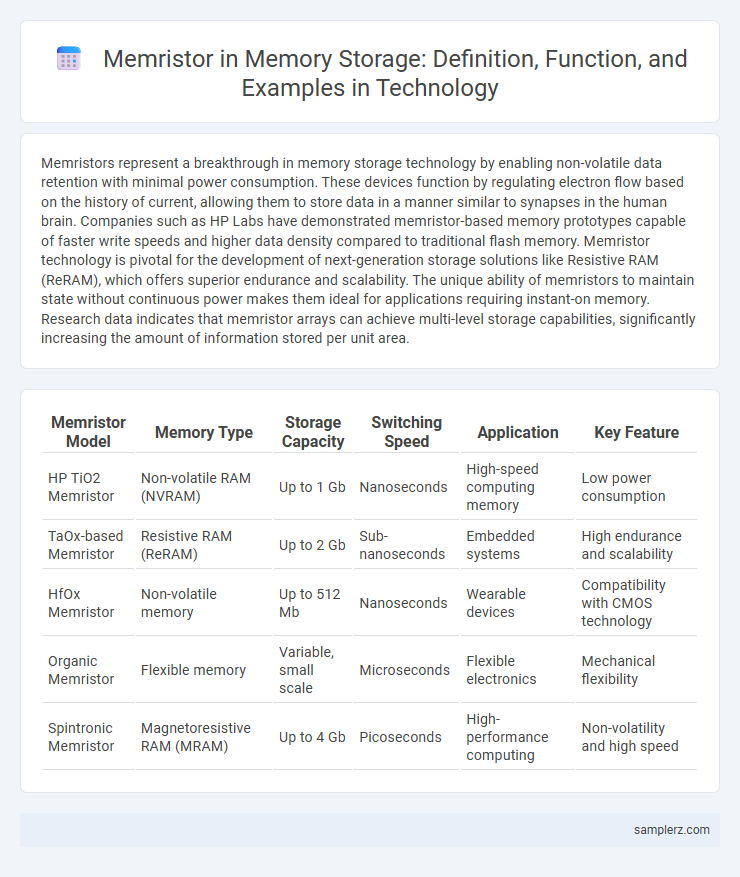Memristors represent a breakthrough in memory storage technology by enabling non-volatile data retention with minimal power consumption. These devices function by regulating electron flow based on the history of current, allowing them to store data in a manner similar to synapses in the human brain. Companies such as HP Labs have demonstrated memristor-based memory prototypes capable of faster write speeds and higher data density compared to traditional flash memory. Memristor technology is pivotal for the development of next-generation storage solutions like Resistive RAM (ReRAM), which offers superior endurance and scalability. The unique ability of memristors to maintain state without continuous power makes them ideal for applications requiring instant-on memory. Research data indicates that memristor arrays can achieve multi-level storage capabilities, significantly increasing the amount of information stored per unit area.
Table of Comparison
| Memristor Model | Memory Type | Storage Capacity | Switching Speed | Application | Key Feature |
|---|---|---|---|---|---|
| HP TiO2 Memristor | Non-volatile RAM (NVRAM) | Up to 1 Gb | Nanoseconds | High-speed computing memory | Low power consumption |
| TaOx-based Memristor | Resistive RAM (ReRAM) | Up to 2 Gb | Sub-nanoseconds | Embedded systems | High endurance and scalability |
| HfOx Memristor | Non-volatile memory | Up to 512 Mb | Nanoseconds | Wearable devices | Compatibility with CMOS technology |
| Organic Memristor | Flexible memory | Variable, small scale | Microseconds | Flexible electronics | Mechanical flexibility |
| Spintronic Memristor | Magnetoresistive RAM (MRAM) | Up to 4 Gb | Picoseconds | High-performance computing | Non-volatility and high speed |
Understanding Memristors: Revolutionizing Memory Storage
Memristors, as non-volatile memory devices, enable ultra-fast data storage with significantly lower power consumption compared to traditional flash memory. Their ability to retain resistance states without power facilitates high-density storage solutions for next-generation computing systems. This technology is pivotal in advancing neuromorphic computing, enhancing memory scalability and energy efficiency.
Key Characteristics of Memristor-Based Memory Devices
Memristor-based memory devices exhibit non-volatility, enabling data retention without power consumption, making them highly energy-efficient. They offer high switching speeds on the order of nanoseconds and excellent scalability, supporting dense memory arrays beyond traditional CMOS limits. These devices also possess remarkable endurance, sustaining millions of write-erase cycles, which enhances their suitability for next-generation storage technologies.
Real-World Examples of Memristor Applications in Storage
Memristors have been integrated into advanced memory storage devices like Resistive Random Access Memory (ReRAM), which offers faster data processing and lower power consumption compared to traditional flash memory. Companies such as HP and Intel have developed memristor-based storage prototypes that demonstrate significant improvements in non-volatile memory density and endurance. These real-world applications highlight the potential of memristors to revolutionize data storage solutions through enhanced speed, scalability, and energy efficiency.
Memristor vs. Traditional RAM: Performance Comparison
Memristor-based memory exhibits non-volatile characteristics, allowing data retention without power, unlike traditional RAM which loses data when powered off. Memristors offer faster switching speeds and significantly lower power consumption, improving overall performance and energy efficiency in memory storage applications. Their potential for higher storage density and endurance makes memristor technology a promising alternative to conventional RAM in next-generation computing systems.
Neuromorphic Computing: Memristor Memory in Artificial Intelligence
Memristors serve as fundamental components in neuromorphic computing by emulating synaptic functions for artificial intelligence applications. Their ability to retain resistance states enables efficient, low-power memory storage that mimics neural plasticity in brain-inspired AI systems. Integration of memristor-based memory enhances real-time learning and adaptation capabilities in advanced AI architectures.
Case Study: HP’s Memristor Memory Technology
HP's memristor memory technology demonstrates a significant breakthrough in non-volatile memory storage, utilizing resistive switching to achieve faster write speeds and lower power consumption compared to traditional flash memory. The case study highlights the potential for memristors to enable high-density storage with enhanced durability, supporting applications in both consumer electronics and data centers. By integrating memristor arrays, HP aimed to overcome scalability limitations of current memory technologies, paving the way for next-generation memory solutions.
Benefits of Memristor Memory Storage for Data Centers
Memristor memory storage significantly enhances data center efficiency by offering ultra-fast data access speeds and ultra-low power consumption compared to traditional memory technologies. Its non-volatile nature ensures data retention without constant power, reducing operational costs and improving system reliability. The scalability and high-density storage capacity of memristors support large-scale data environments, enabling faster processing and reduced physical footprint for data centers.
Energy Efficiency in Memristor-Based Storage Solutions
Memristor-based memory storage solutions offer significant energy efficiency by reducing power consumption during data retention and write operations compared to traditional flash memory. Their non-volatile nature minimizes the need for continuous power, enabling ultralow standby energy usage in applications like embedded systems and IoT devices. Research demonstrates memristors can achieve up to 90% reduction in energy consumption, making them ideal for sustainable and high-performance memory architectures.
Challenges in Commercializing Memristor Memory Technologies
Memristor memory technologies face significant challenges in commercialization due to device variability, limited endurance, and integration complexity with existing CMOS processes. Achieving stable and reliable switching behavior under diverse operating conditions remains a critical hurdle for mass production. Furthermore, controlling sneak-path currents in large memristor arrays demands advanced circuit design and fabrication techniques to ensure data integrity and energy efficiency.
Future Prospects: Memristor Memory in Next-Generation Computing
Memristor memory offers significant advantages for next-generation computing by enabling ultra-fast data access and non-volatile storage with lower power consumption than traditional flash memory. Its ability to mimic synaptic functions paves the way for advanced neuromorphic computing architectures that enhance artificial intelligence performance. Future prospects include integration into high-density storage devices and energy-efficient, brain-inspired computing systems revolutionizing data centers and edge devices.

example of memristor in memory storage Infographic
 samplerz.com
samplerz.com